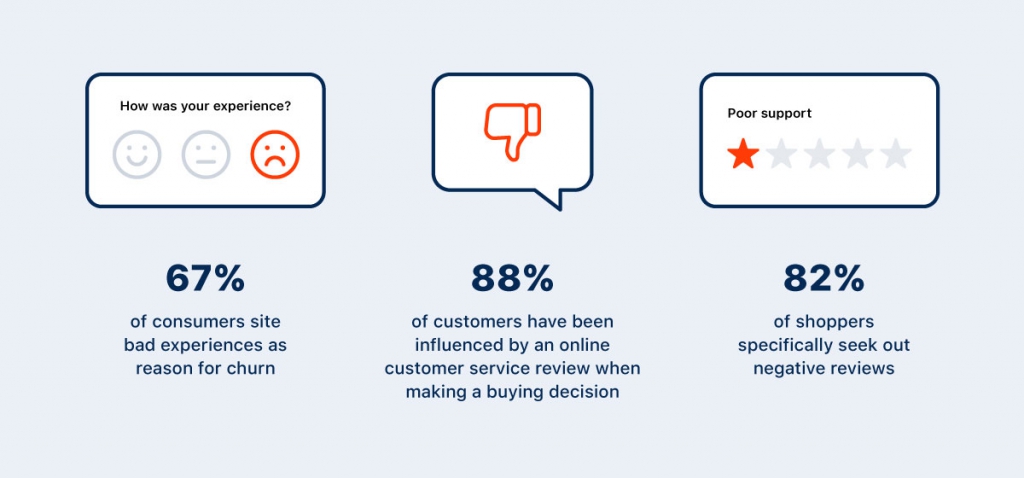Every company gets negative customer feedback. It will happen, no matter how hard you try to be flawless.
Bad feedback can have many root causes. It can be a real issue, or just a customer having a bad day. There’s no way to put a complete end to it. The only thing you can control is how you react.
Here are some scary stats to get you thinking:
- 61% of customers would switch to a competitor after just one bad experience
- 88% of customers have been influenced by an online customer service review when making a buying decision
- 82% of shoppers specifically seek out negative reviews

Negative customer experiences (especially public ones) can harm your reputation a lot. However, it’s only really bad if you don’t handle it well. Or, even worse, don’t handle it at all.
You can not only handle it, but handle it great. The idea is not to just defuse the negativity, but to turn it into a positive experience.
The first obvious benefit of this effort is making the customer feel better. An added bonus is other people seeing and hearing how you deal with tough situations. They’ll have a good first impression of how you do support, even if they haven’t had to reach out themselves.
7 out of 10 consumers changed their opinion about a brand after the company replied to a review.
It’s time to stop thinking of negative feedback as a horrible thing or a chore. Start considering it an opportunity.
Today, we’re going to share some tips on how to do that.
Don’t treat public and private feedback differently
Angry customers often prefer to express their frustration in a public place.

It happens to everyone. For example, here’s a (very much justified) piece of not-so-great feedback about Canny on Twitter:

It’s scary to have something bad about you out in the open. It’s not just that one customer who’s disappointed. Everyone else can also see it.
If you deal with the situation badly, it can skew their opinion of you, whether they’re a customer themselves or not.
If they are, they might refrain from contacting you for support in the future.
If they’re not, they’ll remember that negative comment when they’re looking for a solution like yours.

The public aspect can make you want to deal with this feedback more promptly or thoroughly.
Yes, public complaints are much worse for your reputation. But, that doesn’t mean you should treat them any differently.
Consumers are smart. They can tell if you only put effort into the stuff that is out in the open. If you don’t put the same thought into private issues, the word will get out, whether you like it or not.
You can’t have your bad support skeletons coming out of the closet if you don’t have any. Keep the same standards and practices for every interaction with a dissatisfied customer. Your reputation will be known inside and out.
Take the high road
Some people are bad at controlling their emotions when they’re upset. Some people even get downright mean and degrading.
We’re all human, and it’s hard not to get upset at it. It’s also not nice to be the one who gets whipped for someone having a bad day. However, returning the aggression will only fuel the fire.
Here’s the key to not losing your marbles: don’t take it personally. This isn’t about you. Irrationally angry customers are not a reflection on your skills, personality, or worth.
Remove yourself from being a part of the issue. You are not the problem, you are solving the problem. You’re going to be the solution. Stay calm—it’ll pay off.
Important note: being nice should have limits. If the abuse from a customer is constant, excessive, or completely unreasonable, don’t take it.
Taking the high road doesn’t mean allowing people to walk all over you. Fighting back is something many businesses are scared of doing. Yet, sometimes it’s the way to go.
Here’s an example of patience running thin after a customer ignored support that was offered:

Notice how even after Proposify’s representative being “snappy” with a customer, the issue was taken to be discussed elsewhere. The result was a satisfied customer.
Sometimes, you have to stand your ground. Otherwise, keep calm, breathe, and don’t take it personally.
Admit when you’ve messed up
Having a bad experience is already frustrating enough. The people responsible for it denying it makes it much worse.
Whether your company is big or small, it can be hard to fully accept when you’ve messed up. It’s normal to want to defend what you’ve built.
However, think of negative feedback as a tool, not an attack. Complaints are there for you to realize the weak links in what you’re doing.

Negative feedback helps you find things and aspects of your business to fix, so you can do even better. Doing even better will make you even prouder of what you’ve built.
Admitting to your faults isn’t a sign of weakness, it’s a sign of strength. It shows that you’re brave enough to own up to your issues, and fix them.
Have a sense of humor
You’re not a support robot. You’re a human being. Your customers are also human beings.
If the customer isn’t upset to the point of being angry, a healthy sense of humor can help the situation a lot.

However, use your right to be witty very carefully. There is a very thin line between tasteful banter and making the whole issue a joke.
You still want your customer to feel like they’re being taken seriously. Never poke fun at them—only yourself.
Respond fast, but not too fast
It’s understandable that customers expect fast replies to their complaints. Since delays in responses fuel the fire, it’s easy to rush into defusing the situation ASAP.
Think it through before you do—especially with very angry and sensitive customers. A quick reply is only good when it’s useful and calculated.
A quick reply that doesn’t contain any good information or actionable steps is useless. In some cases, it can make the customer even angrier. Nobody wants to get excited about a response, just to find that it’s a filler.

Analyze the problem, look into the customer, and carefully calibrate your reply. Your aim is to provide as much value as you can, while still being reasonably swift.
Your customer will notice the effort you put into thinking about it before you replied. That recognition will override most time issues.
Always update and follow up
The main solace for an upset customer is knowing that you have heard them. That means knowing that you are are actively dealing with the issue.
Updating them only when you’re done with fixing something or coming up with a solution isn’t enough.
Try and keep them in the loop throughout the whole process and all developments:
- If you have to talk to another team member, let them know
- If they need time to look into it, let them know
- When you’re working on a fix, let them know
- If there’s a time estimate, let them know

In any other situation, too much communication is generally seen as annoying. When you’re solving a problem, especially if it’s a big one, a lot of communication is appreciated.
Don’t forget to follow up in all channels. If you start a private conversation about a public issue, go back to it later and mention the solution there.

This way, if anyone finds it while looking for reviews, they’ll see it has been resolved.
Ask questions
There’s almost always more to a complaint than it initially seems to complain. Ask specifying questions about every piece of negative customer feedback.

Sometimes, people can perceive being asked questions as an attack. They might think you’re doubting their issue, or don’t believe them.
Explain that the questions are to specify the details of an issue and get to the bottom of it as quickly as possible.
Ask your customers to be part of the solution, and don’t view them as part of the problem—Alan Weiss
Remember—it’s not you versus the customer. It’s both of you versus the issue. Let your customers know that they’re a part of the solution, and a tremendous help.
Listen (really listen)
You might think that you know what a customer is talking or complaining about before they even say much. You’ve heard it before—you know what’s coming next. We’ve all seen these “typical” issues.
It’s easy to cut them off before they can really finish talking (or writing).
Here are the issues with cutting your customers off:
- First of all, rude. It doesn’t matter how many times you’ve heard it, still rude.

- Secondly, you might know what the issue is. You might not.
- Finally, if you allow people to finish talking, they might reveal additional information or problems you weren’t even aware of.
Always fight the urge to not hear the customer out fully. It’s easy enough to smile and nod until they’re completely done.
Besides giving you all the information and reducing time spent on firing questions back and forth, listening will calm them down. Being really listened to reassures them that you really are paying attention.
Personalize as much as possible
As we mentioned before, angry people expect responses fast. They don’t want to spend extra time on reciting answers to questions you should already know.
Before you reply, look into the customer and their history:
- What’s their name and who are they?
- Have they had issues before?
- Have you had any communication before?
- Are they an old or new customer?
- How much have they used your product or service?
- What do they do/what does their business do?

According to a survey by Microsoft, most customers actually expect you to be aware of their background before talking to you:

Don’t treat your customers like random people. They’ve trusted you with their business. You owe them the effort of looking into their individual details so they don’t have to deal with it.
Create a customer support “style guide” to help with consistency
Consistency is incredibly important when dealing with upset customers. Issues usually arise when there’s several people involved in the communication.
If the initial responder is nice, understanding, and detailed, and the next one isn’t, it’s going to ruin the experience again.
Ideally, the whole company has the same, consolidated idea of how to talk the talk and walk the walk.

Not everyone has the time or resources to work on support guidelines. However, try to at least have a basic outline of how to act in complicated situations.
If you do have the chance, creating a handy customer support style guide will keep everyone on the same page.
Embrace the negative customer feedback
Every bad customer experience is a chance to grow, learn, and turn things around. It’ll also help you build a great reputation.
Let go of being cramped, defensive, or scared of negative customer feedback.
If you handle it in a graceful manner, the word will spread, and you can enjoy the process while improving your business.
What’s the worst piece of feedback you’ve ever received? How did you handle it?




